History of Villa Vassilieff
The following chronology is an attempt to retrace the history of the Villa Vassilieff, with the desire to highlight the progression of our inquiry through various sources, at times incomplete or contradictory. We would like to thank all the people who contributed to this research through interviews and publications.
1909? November 1911? 1912? : Marie Vassilieff settled in her atelier at 21 Avenue du Maine, and opened the Marie Vassilieff Academy.
The dates of Marie Vassilieff’s arrival and the opening of her academy at 21 Avenue du Maine remain uncertain. Nevertheless, thanks to a correspondence between Vassilieff and Henri Matisse, we can deduct that the Marie Vassilieff Academy was founded during the second half of the year 1911. Indeed, Vassilieff was still part of the Russian Academy in the beginning of that year because she asked Matisse to participate in a lottery organized in its favor, but she announced the foundation of her own academy to her old master just few months later in a letter dated on 8 December 1911.


- "... Above all pragmatic, Marie Vassilieff used Matisse’s support to the maximum, claiming herself his pupil at the Salon d’Automne and convincing him to work for a lottery in order to help the new Russian Academy. (She was later accused of diverting funds and resigned from her role as secretary in order to open her own academy). note 47. M. Vassilieff in HM, 8.12.11, AMP.", Images from Hilary Spurling’s book "Matisse: le maître, 1909-1954" (translated to French by Paule Guivrach, Paris, Editions du Seuil, 2009), taken on October 10, 2015.
Images © All rights reserved

- " Meets Matisse and becomes his pupil. 1908 Founds the Russian Academy. 1909 Founds the Vassilieff Academy, a meeting place for the artistic and literary worlds. Participates in the Salon des Indépendants and in the Salon…", Image from Serge Fauchereau’s book "Paris-Moscou, 1900-1930" (Exhibition Catalogue. Paris, Centre Georges Pompidou, 1979) taken on October, 9 2015.
Image © All rights reserved
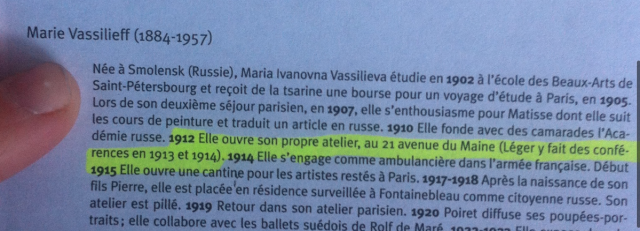
- "1912. She opens her own atelier, at 21 Avenue du Maine (Léger gave two lectures there in 1913 and 1914)." , Image from Catherine Gonnard’s and Élisabeth Lebovici’s book "Femmes artistes, artistes femmes: Paris, de 1880 à nos jours" (Paris, Hazan, 2007), taken on October 9, 2015.
Image © All rights reserved
February 1915- winter 1915? 917? 1918? : Marie Vassilieff opened a canteen in her studio for neighborhing artists who were facing hard living conditions during the war.
If everyone agrees on the year of the opening of the canteen, the date of its closure is less clear. It was presumably permanently closed during the 1915 winter when Marie Vassilieff left Paris for Russia. But it may have re-opened when the artist came back to Paris, and would then have closed in 1917 when Vassilieff was arrested by the French police for suspicion of being a Bolshevik spy.

- "From 1915 to 1918, Marie Vassilieff opened La Cantine des Artistes.", Image of the Plate installed at the entrance of 21 Avenue du Maine taken on May 23, 2014
Image © All rights reserved

- “… that functioned until 1917”. , Image of an exhibition text in the Musée du Montparnasse taken on May 23, 2014.
Image © All rights reserved
1924? 1929? 1934?: Marie Vassilieff moved out of her studio at 21 Avenue du Maine.
Both the moving date of Vassilieff and her destination are a debatable matter; some believe that she moved to 37 rue Froideveaux, others think it was number 54 on the same street and then some ascertain that it was 54 Avenue du Maine (the former address of The Russian Academy also founded by Marie Vassilieff). Another uncertainty is the future of the atelier at 21 Avenue du Maine: did Vassilieff keep it to transform it into a museum? Did she open her own Vassilieff Museum elsewhere? Or did she ever open a museum? One thing is certain – through an ad that she published – by 1929 Vassilieff was at 37rue Froideveaux, so she had left her previous studio before this date.
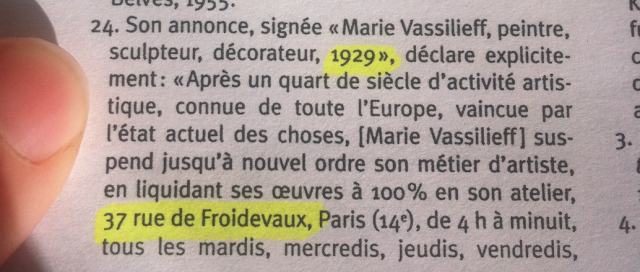
- Image of Catherine Gonnard’s and Élisabeth Lebovici’s book "Femmes artistes, artistes femmes: Paris, de 1880 à nos jours" (Paris, Hazan, 2007), taken on the October 9, 2015. Image © All rights reserved


- Image of Billy Klüver’s and Julie Martin’s book: "Kiki et Montparnasse: 1900-1930", (translated from English: Edith Ochs, Paris, Flammarion, 1989) taken on October 9, 2015. Images © All rights reserved

- "She lived and worked here until 1929." , Image of the Plate installed at the entrance of 21 Avenue du Maine taken on May 23, 2014
Image © All rights reserved

- "1934 Moves to 54 Avenue Froidevaux (Paris, 14th arrondissement) and opens the Vassilieff Museum.", Screenshot of Marie Vassiliff’s page in the website russie.net (http://www.russie.net/article5859.html), accessed on October 10, 2015.
Image © All rights reserved

- "In 1934, she organized the Marie-Vassilieff Museum in her new studio at 54 Avenue du Maine, where she exhibited her paintings, dolls, masks and icons." , Image of Andreï and Vladimir Hofmann’s book, "Les artistes russes hors frontière" (Exhibition Catalogue, Paris, Musée du Montparnasse, 2010), taken on October 10, 2015.
Image © All rights reserved

- "To avoid the evacuation of her studio, she gatherd all her works at her place, Avenue du Maine, and created there in her apartament the Vassilieff Museum." , Image of Catherine Gonnard’s and Élisabeth Lebovici’s book "Femmes artistes, artistes femmes: Paris, de 1880 à nos jours" (Paris, Hazan, 2007), taken on October 9, 2015.
Image © All rights reserved
January 1939 : Roger Pic moves into the aisle in his first studio which serves as rehearsal room for his amateur troupe. In 1945, after the Libération, he converts two of the aisle studios - including the Villa Vassilieff one, where the Pernod Ricard Fellows are now hosted - into his home and his photography studio.
October 13, 1951: Opening of the Musée de Montparnasse under the leadership of its director Marc Vaux.

- "Succeeding the Montparnasse Academy (1912-1950) where Gromaire and Despierre had taught, Marc Vaux created a small museum of Montparnasse between 1951 and 1963. He exhibited many works and documents by painters of the neighbourhood that he was friend with and that he often photographed.", Image of the Plate installed at the entrance of 21 Avenue du Maine taken on May 23, 2014.
Image © All rights reserved
If the official address of this small museum is on 10 rue de l’Arrivée, it was actually located in the aisle of 21 avenue du Maine which, at that time, was connected to 10 rue de l’Arrivée until the construction works made in the 1960s during the construction of the Montparnasse Tower — which probably led to the closure of the museum, destroyed that part of the aisle.
There is a debate around the location of the “Montparnasse Academy” at 21 Avenue du Maine. Indeed, beside the issue of its name (Montparnasse Academy, Academy of Montparnasse, Academy Montparnasse?), its address also changed often, according to the various sources: sometimes it was located at 21 Avenue du Maine, sometimes at 10 rue de l’Arrivée. However, this is perhaps due to a confusion with the address of Académie La Palette at 35 rue du Départ. Moreover, if it is sure that Despierre was a teacher at this Montparnasse Academy, it is not certain that Gromaire taught there.
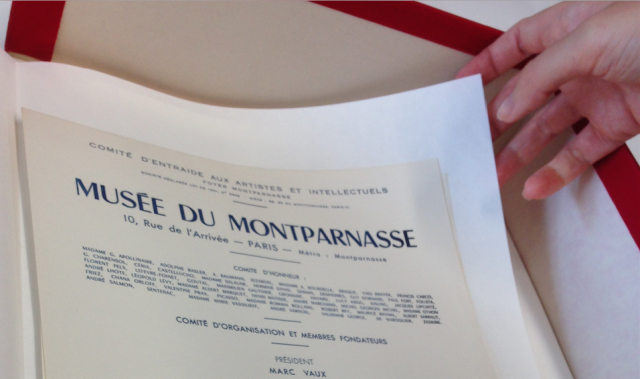
- Image of a document from the Marc Vaux Archive, conserved at the Kandinsky Library (Musée National d’Art Moderne / Centre Pompidou) taken on July 24, 2015. Image © All rights reserved

- "… the Montparnasse academy- 10 rue de l’Arrivée.", Image of Jean-Paul Crespelle’s book "Montparnasse vivant" (Paris, Librairie Hachette, 1962), taken on September 25, 2015.
Image © All rights reserved
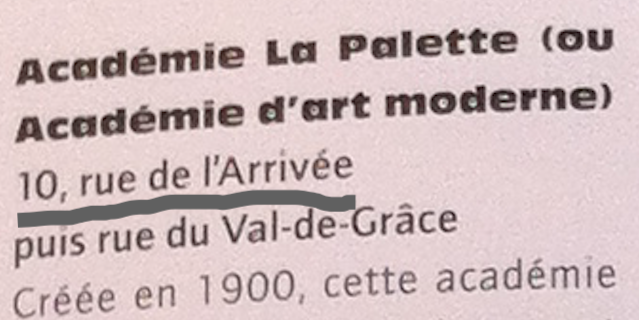
- Image of Jean-Louis Andral’s and Sophie Krebs’s book "L’école de Paris, 1904-1929: la part de l’autre" (Exhibition Catalogue, Paris, Paris-Musées, 2000), taken on October 9, 2015. Image © All rights reserved
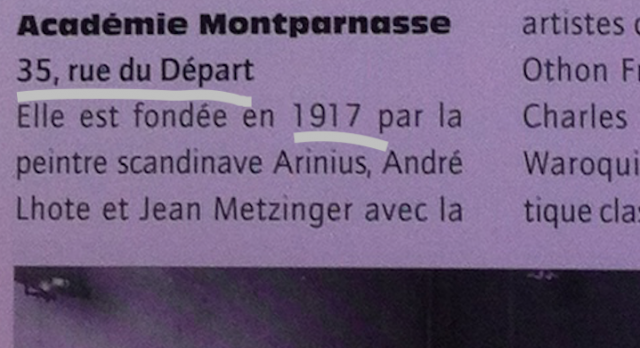
- Image of Jean-Louis Andral’s and Sophie Krebs’s book "L’école de Paris, 1904-1929: la part de l’autre" (Exhibition Catalogue, Paris, Paris-Musées, 2000), taken on October 9, 2015. Image © All rights reserved

- "1948: he teaches at the Montparnasse Academy." , Image of François and Danielle Ceria’s (dir.) book, "Despierre (1912-1995)" (Paris, Somogy, 2003), taken on October 10, 2015.
Image © All rights reserved
Early 1960s : Frans Krajcberg moves his studio in the aisle of the 21 avenue du Maine. He occupied the left space of the current Villa Vassilieff’s first floor until the beginning of the 2000s (?).
1963 : Marc Vaux’s Musée du Montparnasse closes.
1972 : the Atelier Annick Le Moine opens on Villa Vassilieff’s current first floor. This gallery has been an important place of the Parisian art scene for fifteen years. Annick Le Moine organized numerous exhibitions, concerts and performances there .
1987 : Annick Le Moine passes away; Charles Sablon — who was then living on the current Villa’s ground floor - takes over the former space of her gallery to open his, which was since 1984 located in the bottom of the aisle.
1993 : Charles Sablon passes away, leading to the closure of his gallery.
May 28, 1998: The Musée du Montparnasse non-profit organization created by Roger Pic and Jean-Marie Drot opens its doors at the former atelier of Marie Vassilieff.
Early 200s: the Musée du Montparnasse expands by taking over Frans Krajcberg’s studio – the left room at the Villa Vassilieff first floor – who move to the ground floor in the Gigi Guadagnucci former studio.
2013: The Montparnasse Museum closes.
2015: the non-profit organization Bétonsalon re-opened the site of the former Montparnasse Museum with a new space combining artists’ residencies and a research center that will notably address the history of the place, its neighborhood and related archive: Villa Vassilieff.
February 13-14, 2016 : Opening of the Villa Vassilieff.
2016: Opening of Villa Vassilieff and launch of the Pernod Ricard Fellowship.
Chronology by Camille Chenais
Share